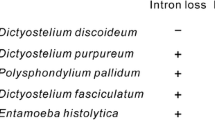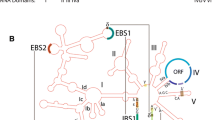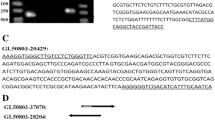Abstract
The genesis of the exon–intron patterns of eukaryotic genes persists as one of the most enigmatic questions in molecular genetics. In particular, the origin and mechanisms responsible for creation of spliceosomal introns have remained controversial. Now the issue appears to have taken a turn. The formation of novel introns in eukaryotes, including some vertebrate lineages, is not as rare as commonly assumed. Moreover, introns appear to have been gained in parallel at closely spaced sites and even repeatedly at the same position. Based on these discoveries, novel hypotheses of intron creation have been developed. The new concepts posit that DNA repair processes are a major source of intron formation. Here, after summarizing the current views of intron gain mechanisms, I review findings in support of the DNA repair hypothesis that provides a global mechanistic scenario for intron creation. Some implications on our perception of the mosaic structure of eukaryotic genes are also discussed.
Similar content being viewed by others
References
Berget SM, Moore C, Sharp PA (1977) Spliced segments at the 5′ terminus of adenovirus 2 late mRNA. Proc Natl Acad Sci USA 74:3171–3175
Chow LT, Gelinas RE, Broker TR, Roberts RJ (1977) An amazing sequence arrangement at the 5′ ends of adenovirus 2 messenger RNA. Cell 12:1–8
Evans RM, Fraser N, Ziff E, Weber J, Wilson M, Darnell JE (1977) The initiation sites for RNA transcription in Ad2 DNA. Cell 12:733–739
Wahl MC, Will CL, Lührmann R (2009) The spliceosome: design principles of a dynamic RNP machine. Cell 36:701–718
Collins L, Penny D (2005) Complex spliceosomal organization ancestral to extant eukaryotes. Mol Biol Evol 22:1053–1066
Russell AG, Charette JM, Spencer DF, Gray MW (2006) An early evolutionary origin for the minor spliceosome. Nature 443:863–866
Roy SW, Gilbert W (2006) The evolution of spliceosomal introns: patterns, puzzles and progress. Nat Rev Genet 7:211–221
Koonin EV (2006) The origin of introns and their role in eukaryogenesis: a compromise solution to the introns-early versus introns-late debate? Biol Direct 1:22
Penny D, Hoeppner MP, Poole AM, Jeffares DC (2009) An overview of the introns-first theory. J Mol Evol 69:527–540
Raible F, Tessmar-Raible K, Osoegawa K, Wincker P, Jubin C, Balavoine G, Ferrier D, Benes V, de Jong P, Weissenbach J, Bork P, Arendt D (2005) Vertebrate-type intron-rich genes in the marine annelid Platynereis dumerilii. Science 310:1325–1326
Putnam NH, Srivastava M, Hellsten U, Dirks B, Chapman J, Salamov A, Terry A, Shapiro H, Lindquist E, Kapitonov VV, Jurka J, Genikhovich G, Grigoriev IV, Lucas SM, Steele RE, Finnerty JR, Technau U, Martindale MQ, Rokhsar DS (2007) Sea anemone genome reveals ancestral eumetazoan gene repertoire and genomic organization. Science 317:86–94
Jeffares DC, Mourier T, Penny D (2006) The biology of intron gain and loss. Trends Genet 22:16–22
Carmel L, Wolf YI, Rogozin IB, Koonin EV (2007) Three distinct modes of intron dynamics in the evolution of eukaryotes. Genome Res 17:1034–1044
Logsdon JM Jr, Tyshenko MG, Dixon C, D-Jafari J, Walker VK, Palmer JD (1995) Seven newly discovered intron positions in the triose-phosphate isomerase gene: evidence for the introns-late theory. Proc Natl Acad Sci USA 92:8507–8511
Ragg H, Lokot T, Kamp PB, Atchley WR, Dress A (2001) Vertebrate serpins: construction of a conflict-free phylogeny by combining exon–intron and diagnostic site analyses. Mol Biol Evol 18:577–584
Qiu WG, Schisler N, Stoltzfus A (2004) The evolutionary gain of spliceosomal introns: sequence and phase preferences. Mol Biol Evol 21:1252–1263
Edvardsen RB, Lerat E, Maeland AD, Flåt M, Tewari R, Jensen MF, Lehrach H, Reinhardt R, Seo HC, Chourrout D (2004) Hypervariable and highly divergent intron–exon organizations in the chordate Oikopleura dioica. J Mol Evol 59:448–457
Roy SW, Penny D (2006) Smoke without fire: most reported cases of intron gain in nematodes instead reflect intron losses. Mol Biol Evol 23:2259–2262
Knowles DG, McLysaght A (2006) High rate of recent intron gain and loss in simultaneously duplicated Arabidopsis genes. Mol Biol Evol 23:1548–1557
Roy SW, Penny D (2007) A very high fraction of unique intron positions in the intron-rich diatom Thalassiosira pseudonana indicates widespread intron gain. Mol Biol Evol 24:1447–1457
Farlow A, Meduri E, Dolezal M, Hua L, Schlötterer C (2010) Nonsense-mediated decay enables intron gain in Drosophila. PLoS Genet 6:e1000819
Omilian AR, Scofield DG, Lynch M (2008) Intron presence–absence polymorphisms in Daphnia. Mol Biol Evol 25:2129–2139
Li WL, Tucker AE, Sung W, Thomas WK, Lynch M (2009) Extensive, recent intron gains in Daphnia populations. Science 326:1260–1262
Schiöth HB, Haitina T, Fridmanis D, Klovins J (2005) Unusual genomic structure: melanocortin receptors in Fugu. Ann NY Acad Sci 1040:460–463
Moriyama S, Oda M, Yamazaki T, Yamaguchi K, Amiya N, Takahashi A, Amano M, Goto T, Nozaki M, Meguro H, Kawauchi H (2008) Gene structure and functional characterization of growth hormone in dogfish, Squalus acanthias. Zool Sci 25:604–613
Hussain A, Saraiva LR, Korsching SI (2009) Positive Darwinian selection and the birth of an olfactory receptor clade in teleosts. Proc Natl Acad Sci USA 106:4313–4318
Ragg H, Kumar A, Köster K, Bentele C, Wang Y, Frese MA, Prib N, Krüger O (2009) Multiple gains of spliceosomal introns in a superfamily of vertebrate protease inhibitor genes. BMC Evol Biol 9:208
Coulombe-Huntington J, Majewski J (2007) Intron loss and gain in Drosophila. Mol Biol Evol 24:2842–2850
Zhuo D, Madden R, Elela SA, Chabot B (2007) Modern origin of numerous alternatively spliced human introns from tandem arrays. Proc Natl Acad Sci USA 104:882–886
Roy SW, Irimia M (2008) When good transcripts go bad: artifactual RT-PCR ‘splicing’ and genome analysis. Bioessays 30:601–605 (comment in: Bioessays 30:1256; author reply 1257–1258)
Rodríguez-Trelles F, Tarrío R, Ayala FJ (2006) Origins and evolution of spliceosomal introns. Annu Rev Genet 40:47–76
Irimia M, Rukov JL, Penny D, Vinther J, Garcia-Fernandez J, Roy SW (2008) Origin of introns by ‘intronization’ of exonic sequences. Trends Genet 24:378–381
Roy SW, Irimia M (2009) Mystery of intron gain: new data and new models. Trends Genet 25:67–73
Fridell RA, Pret AM, Searles LL (1990) A retrotransposon 412 insertion within an exon of the Drosophila melanogaster vermilion gene is spliced from the precursor RNA. Genes Dev 4:559–566
Giroux MJ, Clancy M, Baier J, Ingham L, McCarty D, Hannah LC (1994) De novo synthesis of an intron by the maize transposable element Dissociation. Proc Natl Acad Sci USA 91:12150–12154
Rushforth AM, Anderson P (1996) Splicing removes the Caenorhabditis elegans transposon Tc1 from most mutant pre-mRNAs. Mol Cell Biol 16:422–429
Coghlan A, Wolfe KH (2004) Origins of recently gained introns in Caenorhabditis. Proc Natl Acad Sci USA 101:11362–11367
Fedorov A, Roy S, Fedorova L, Gilbert W (2003) Mystery of intron gain. Genome Res 13:2236–2241
Rogers JH (1989) How were introns inserted into nuclear genes? Trends Genet 5:213–216
Figueroa F, Ono H, Tichy H, O’Huigin C, Klein J (1995) Evidence for insertion of a new intron into an Mhc gene of perch-like fish. Proc Biol Sci 259:325–330
Roy SW (2009) Intronization, de-intronization and intron sliding are rare in Cryptococcus. BMC Evol Biol 9:192
Gao X, Lynch M (2009) Ubiquitous internal gene duplication and intron creation in eukaryotes. Proc Natl Acad Sci USA 106:20818–20823
Krull M, Brosius J, Schmitz J (2005) Alu-SINE exonization: en route to protein-coding function. Mol Biol Evol 22:1702–1711
Schmidt EE, Davies CJ (2007) The origins of polypeptide domains. Bioessays 29:262–270
Lev-Maor G, Sorek R, Levanon EY, Paz N, Eisenberg E, Ast G (2007) RNA-editing-mediated exon evolution. Genome Biol 8:R29
Sorek R (2007) The birth of new exons: mechanisms and evolutionary consequences. RNA 13:1603–1608
Gladyshev EA, Meselson M, Arkhipova IR (2008) Massive horizontal gene transfer in bdelloid rotifers. Science 320:1210–1213
Gladyshev E, Meselson M (2008) Extreme resistance of bdelloid rotifers to ionizing radiation. Proc Natl Acad Sci USA 105:5139–5144
Mark Welch DB, Mark Welch JL, Meselson M (2008) Evidence for degenerate tetraploidy in bdelloid rotifers. Proc Natl Acad Sci USA 105:5145–5149
Hur JH, Van Doninck K, Mandigo ML, Meselson M (2009) Degenerate tetraploidy was established before bdelloid rotifer families diverged. Mol Biol Evol 26:375–383
Seo HC, Kube M, Edvardsen RB, Jensen MF, Beck A, Spriet E, Gorsky G, Thompson EM, Lehrach H, Reinhardt R, Chourrout D (2001) Miniature genome in the marine chordate Oikopleura dioica. Science 294:2506 [Erratum in: Science 295:45 (2002)]
Gasior SL, Wakeman TP, Xu B, Deininger PL (2006) The human LINE-1 retrotransposon creates DNA double-strand breaks. J Mol Biol 357:1383–1393
Vilenchik MM, Knudson AG (2003) Endogenous DNA double-strand breaks: production, fidelity of repair, and induction of cancer. Proc Natl Acad Sci USA 100:12866–12871
Lieber MR, Ma Y, Pannicke U, Schwarz K (2003) Mechanism and regulation of human non-homologous DNA end-joining. Nat Rev Mol Cell Biol 4:712–720
Haber JE (1999) DNA recombination: the replication connection. Trends Biochem Sci 24:271–275
Pardo B, Gómez-González B, Aguilera A (2009) DNA repair in mammalian cells: DNA double-strand break repair: how to fix a broken relationship. Cell Mol Life Sci 66:1039–1056
Hartlerode AJ, Scully R (2009) Mechanisms of double-strand break repair in somatic mammalian cells. Biochem J 423:157–168
Wells RD, Dere R, Hebert ML, Napierala M, Son LS (2005) Advances in mechanisms of genetic instability related to hereditary neurological diseases. Nucleic Acids Res 33:3785–3798
Shishkin AA, Voineagu I, Matera R, Cherng N, Chernet BT, Krasilnikova MM, Narayanan V, Lobachev KS, Mirkin SM (2009) Large-scale expansions of Friedreich’s ataxia GAA repeats in yeast. Mol Cell 35:82–92
Sasaki M, Lange J, Keeney S (2010) Genome destabilization by homologous recombination in the germ line. Nat Rev Mol Cell Biol 11:182–195
Mahaney BL, Meek K, Lees-Miller SP (2009) Repair of ionizing radiation-induced DNA double-strand breaks by non-homologous end-joining. Biochem J 417:639–650
Lieber MR, Lu H, Gu J, Schwarz K (2008) Flexibility in the order of action and in the enzymology of the nuclease, polymerases, and ligase of vertebrate non-homologous DNA end joining: relevance to cancer, aging, and the immune system. Cell Res 18:125–133
Lieber MR (2010) The mechanism of double-strand DNA break repair by the nonhomologous DNA end-joining pathway. Annu Rev Biochem 79:181–211
Liang F, Han M, Romanienko PJ, Jasin M (1998) Homology-directed repair is a major double-strand break repair pathway in mammalian cells. Proc Natl Acad Sci USA 95:5172–5177
Haviv-Chesner A, Kobayashi Y, Gabriel A, Kupiec M (2007) Capture of linear fragments at a double-strand break in yeast. Nucleic Acids Res 35:5192–5202
Lin Y, Waldman AS (2001) Capture of DNA sequences at double-strand breaks in mammalian chromosomes. Genetics 158:1665–1674
Lin Y, Waldman AS (2001) Promiscuous patching of broken chromosomes in mammalian cells with extrachromosomal DNA. Nucleic Acids Res 29:3975–3981
Odersky A, Panyutin IV, Panyutin IG, Schunck C, Feldmann E, Goedecke W, Neumann RD, Obe G, Pfeiffer P (2002) Repair of sequence-specific 125I-induced double-strand breaks by nonhomologous DNA end joining in mammalian cell-free extracts. J Biol Chem 277:11756–11764
Jensen-Seaman MI, Wildschutte JH, Soto-Calderón ID, Anthony NM (2009) A comparative approach shows differences in patterns of numt insertion during hominoid evolution. J Mol Evol 68:688–699
Ruiz-Herrera A, Nergadze SG, Santagostino M, Giulotto E (2008) Telomeric repeats far from the ends: mechanisms of origin and role in evolution. Cytogenet Genome Res 122:219–228
Leister D (2005) Origin, evolution and genetic effects of nuclear insertions of organelle DNA. Trends Genet 21:655–663
Hazkani-Covo E, Covo S (2008) Numt-mediated double-strand break repair mitigates deletions during primate genome evolution. PLoS Genet 4:e1000237
Gu J, Lu H, Tippin B, Shimazaki N, Goodman MF, Lieber MR (2007) XRCC4:DNA ligase IV can ligate incompatible DNA ends and can ligate across gaps. EMBO J 26:1010–1023 (Erratum in: EMBO J 26:3506–3507)
Moon AF, Garcia-Diaz M, Bebenek K, Davis BJ, Zhong X, Ramsden DA, Kunkel TA, Pedersen LC (2007) Structural insight into the substrate specificity of DNA polymerase μ. Nat Struct Mol Biol 14:45–53
Gozalbo-López B, Andrade P, Terrados G, de Andrés B, Serrano N, Cortegano I, Palacios B, Bernad A, Blanco L, Marcos MA, Gaspar ML (2009) A role for DNA polymerase μ in the emerging DJH rearrangements of the postgastrulation mouse embryo. Mol Cell Biol 29:1266–1275
Andrade P, Martín MJ, Juárez R, López de Saro F, Blanco L (2009) Limited terminal transferase in human DNA polymerase μ defines the required balance between accuracy and efficiency in NHEJ. Proc Natl Acad Sci USA 106:16203–16208
Burgers PM, Koonin EV, Bruford E, Blanco L, Burtis KC, Christman MF, Copeland WC, Friedberg EC, Hanaoka F, Hinkle DC, Lawrence CW, Nakanishi M, Ohmori H, Prakash L, Prakash S, Reynaud CA, Sugino A, Todo T, Wang Z, Weill JC, Woodgate R (2001) Eukaryotic DNA polymerases: proposal for a revised nomenclature. J Biol Chem 276:43487–43490
Yu AM, McVey M (2010) Synthesis-dependent microhomology-mediated end joining accounts for multiple types of repair junctions. Nucleic Acids Res. doi:10.1093/nar/gkq379
Sheth N, Roca X, Hastings ML, Roeder T, Krainer AR, Sachidanandam R (2006) Comprehensive splice-site analysis using comparative genomics. Nucleic Acids Res 34:3955–3967
Lin CF, Mount SM, Jarmolowski A, Makalowski W (2010) Evolutionary dynamics of U12-type spliceosomal introns. BMC Evol Biol 10:47
Stalder L, Mühlemann O (2008) The meaning of nonsense. Trends Cell Biol 18:315–321
Catania F, Lynch M (2008) Where do introns come from? PLoS Biol 6:e283
Bowater R, Doherty AJ (2006) Making ends meet: repairing breaks in bacterial DNA by non-homologous end-joining. PLoS Genet 2:e8
Author information
Authors and Affiliations
Corresponding author
Rights and permissions
About this article
Cite this article
Ragg, H. Intron creation and DNA repair. Cell. Mol. Life Sci. 68, 235–242 (2011). https://doi.org/10.1007/s00018-010-0532-2
Received:
Revised:
Accepted:
Published:
Issue Date:
DOI: https://doi.org/10.1007/s00018-010-0532-2




